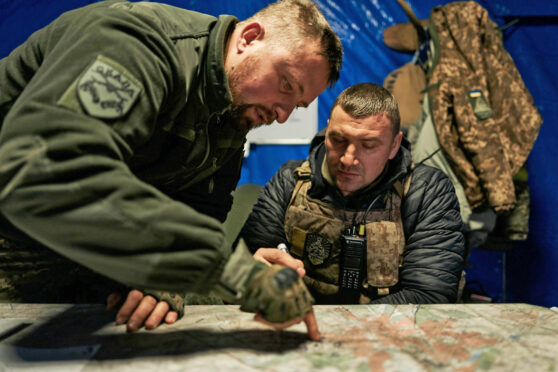
Russia’s invasion of Ukraine suggests “big war is back” with large-scale conflict between nations likely to shape world politics for years to come, according to a military expert.
Ben Barry, senior fellow for land warfare at the respected International Institute for Strategic Studies thinktank, said the conflict had transformed contemporary warfare.
The former British Army brigadier said Ukraine was more like major wars such as the Korean War, the Bosnian conflict or the Iran-Iraq War than a smaller-scale “special military operation” as it was initially described by Russian President Vladimir Putin.
Strategists in the UK and the US have been too preoccupied with counterinsurgency involving campaigns of unconventional, irregular and special operations warfare in countries such as Afghanistan but Ukraine has shifted the focus, Barry said.
He said: “Big War is back. Perhaps the most important facet of the war is that what was planned as a short ‘special military operation’ against an inferior enemy has turned into a large-scale conflict between states in which prolonged fighting has been at a high intensity and over a wide geographical area.
“Both sides in Ukraine are finding it much more difficult to prevail than the US did against the Taliban in 2001 and Iraq in 2003 where it took little more than a month to accomplish regime change.
“This war might be more like the wars in Korea from 1950-53, Bosnia in 1992-95 and between Iran and Iraq from 1980-88. Its outcome, military dynamics and lessons will have a significant influence on global military thinking and planning as defence ministries contemplate possible future wars.”
Barry is a visiting professor at the department of war studies at King’s College London. His most recent book is Blood, Metal And Dust: How Victory Turned Into Defeat In Afghanistan And Iraq.
He said British troops must relearn the art of camouflage and concealment as Ukraine’s drone war has revealed the “transparency” of the modern battlefield while both Russia and Ukraine prepared for heavy fighting in the new year.
He said: “The lesson is that UAVs (unmanned aerial vehicles) and drones are now key capabilities for land forces. This adds a degree of land-air integration to the lowest tactical levels, right down to company and platoon level, that was not achievable in earlier wars including the recent conflict in Nagorno-Karabakh.
“This also means that counter-drone capabilities are similarly required by land forces, including at the lowest tactical level.
“The threat from both UAVs and civilian and military satellite reconnaissance will require US and Nato forces to rediscover the art of camouflage, concealment and deception, which has been lost in recent decades.”
Barry, who also commanded an armoured infantry battalion and a multinational brigade on UN and Nato operations in Bosnia, said Russia and Ukraine were generating fresh forces for a renewal of heavy fighting in 2023. He added: “Ukraine is seeking to field new armoured and mechanised brigades and to integrate the Western equipment it is receiving.
“Its defence chief has openly spoken of moving to a strategic counter-offensive in the medium term. Russia is preparing defensive belts of anti-tank obstacles, minefields and hedgehog positions and at road junctions.
“It is integrating its recently mobilised soldiers and may be continuing to build fresh units and formations. Given the attrition it has suffered this year, it may well refrain from major offensive operations until the spring.”
Barry – who was director of the British Army Staff in the Ministry of Defence and author of the Army’s analysis of post-conflict stabilisation of Iraq – said the tempo of combat in winter could drop but the possibility of lasting peace was still remote.
He said: “Both sides will probably continue to attack each other’s depth with rocket artillery and drone strikes.
“Russia will continue to strike Ukrainian civilian infrastructure and energy installations to pressure Ukrainian civilians – although every cruise missile fired at a transformer is one not fired at a military target.
“The winter weather will reduce both sides’ ability to gain images from satellites and drones. Ukraine will continue to use special forces, partisans and precision missiles, particularly the guided rockets fired from HIMARS launchers to attack key Russian positions, logistic networks and installations, although the weather will reduce the tempo of Ukrainian fighters operating behind Russian lines.
“Both sides will probably continue to skirmish for key terrain, at lower tempo.
“Major Ukrainian tactical counter-offensives are still possible over the winter months. There are a wide variety of operational designs they could use and both will seek to continue to disrupt each other’s plans.
“Both sides in this war have votes and may well choose to cast them over the winter months to seek advantage over each other. This may result in reaction and counter-reaction dynamics. Bouts of heavy fighting before the spring are quite possible.”
Year ends with Russian drones and missiles raining down on Ukraine
Russia launched a fresh missile attack on Ukraine yesterday with explosions throughout the country.
Kyiv’s mayor Vitali Klitschko said at least one person had been killed and 20 wounded, including a journalist from Japan, after a series of explosions in the capital. A hotel, two schools and a nursery were damaged by the attack.
People were also injured in drone and missile attacks in the cities of Mykolaiv and Khmelnytskyi. Russia launched 20 cruise missiles over Ukraine, of which 12 were successfully shot down, according to Ukrainian military chief General Valerii Zaluzhnyi.
First Lady Olena Zelenska expressed outrage at the attacks just before New Year’s Eve celebrations. “Ruining lives of others is a disgusting habit of our neighbours,” she said.
It was also reported yesterday that Russian troops in Ukraine will be exempt from paying income tax in a bid to encourage support for the occupation.

Enjoy the convenience of having The Sunday Post delivered as a digital ePaper straight to your smartphone, tablet or computer.
Subscribe for only £5.49 a month and enjoy all the benefits of the printed paper as a digital replica.
Subscribe